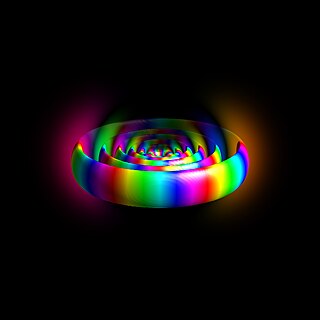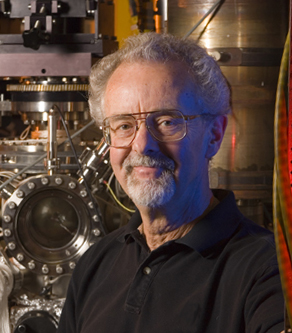Resolved sideband cooling is a laser cooling technique allowing cooling of tightly bound atoms and ions beyond the Doppler cooling limit, potentially to their motional ground state. Aside from the curiosity of having a particle at zero point energy, such preparation of a particle in a definite state with high probability (initialization) is an essential part of state manipulation experiments in quantum optics and quantum computing.

Extended X-ray absorption fine structure (EXAFS), along with X-ray absorption near edge structure (XANES), is a subset of X-ray absorption spectroscopy (XAS). Like other absorption spectroscopies, XAS techniques follow Beer's law. The X-ray absorption coefficient of a material as a function of energy is obtained using X-rays of a narrow energy resolution are directed at a sample and the incident and transmitted x-ray intensity is recorded as the incident x-ray energy is incremented.

A Rydberg atom is an excited atom with one or more electrons that have a very high principal quantum number, n. The higher the value of n, the farther the electron is from the nucleus, on average. Rydberg atoms have a number of peculiar properties including an exaggerated response to electric and magnetic fields, long decay periods and electron wavefunctions that approximate, under some conditions, classical orbits of electrons about the nuclei. The core electrons shield the outer electron from the electric field of the nucleus such that, from a distance, the electric potential looks identical to that experienced by the electron in a hydrogen atom.

Photoexcitation is the production of an excited state of a quantum system by photon absorption. The excited state originates from the interaction between a photon and the quantum system. Photons carry energy that is determined by the wavelengths of the light that carries the photons. Objects that emit light with longer wavelengths, emit photons carrying less energy. In contrast to that, light with shorter wavelengths emit photons with more energy. When the photon interacts with a quantum system, it is therefore important to know what wavelength one is dealing with. A shorter wavelength will transfer more energy to the quantum system than longer wavelengths.
Jozef T. Devreese is a Belgian scientist, with a long career in condensed matter physics. He is Professor Emeritus of Theoretical Physics at the University of Antwerp.
Delbrück scattering, the deflection of high-energy photons in the Coulomb field of nuclei as a consequence of vacuum polarization, was observed in 1975. The related process of the scattering of light by light, also a consequence of vacuum polarization, was not observed until 1998. In both cases, it is a process described by quantum electrodynamics.

Earl Ward Plummer was an American physicist. His main contributions were in surface physics of metals. Plummer was a Professor of Physics at Louisiana State University and the University of Pennsylvania prior to that.

Electron beam ion trap (EBIT) is an electromagnetic bottle that produces and confines highly charged ions. An EBIT uses an electron beam focused with a powerful magnetic field to ionize atoms to high charge states by successive electron impact.
Isaac David Abella was a Canadian physicist who was a professor at the University of Chicago. He specialized in laser physics, quantum optics, and spectroscopy. Isaac was the cousin of Irving Abella.
Photoelectrochemical processes are processes in photoelectrochemistry; they usually involve transforming light into other forms of energy. These processes apply to photochemistry, optically pumped lasers, sensitized solar cells, luminescence, and photochromism.

Resonant inelastic X-ray scattering (RIXS) is an X-ray spectroscopy technique used to investigate the electronic structure of molecules and materials.

Photofission is a process in which a nucleus, after absorbing a gamma ray, undergoes nuclear fission and splits into two or more fragments.
Radiative Auger effect is a decay channel of an inner-shell atomic vacancy state, in which an x-ray photon is emitted accompanying simultaneous promotion of an electron into either a bound or a continuum state. Thus the transition energy is shared between the photon and the electron. The effect was first observed by F. Bloch and P. A. Ross, with initial theoretical explanation by F. Bloch. Later the effect has also been observed on defects in the solid-state, semiconductor quantum emitters, as well as two-dimensional electron gases. In the latter case, the effect is typically referred to as shake-up.
Within quantum cryptography, the Decoy state quantum key distribution (QKD) protocol is the most widely implemented QKD scheme. Practical QKD systems use multi-photon sources, in contrast to the standard BB84 protocol, making them susceptible to photon number splitting (PNS) attacks. This would significantly limit the secure transmission rate or the maximum channel length in practical QKD systems. In decoy state technique, this fundamental weakness of practical QKD systems is addressed by using multiple intensity levels at the transmitter's source, i.e. qubits are transmitted by Alice using randomly chosen intensity levels, resulting in varying photon number statistics throughout the channel. At the end of the transmission Alice announces publicly which intensity level has been used for the transmission of each qubit. A successful PNS attack requires maintaining the bit error rate (BER) at the receiver's end, which can not be accomplished with multiple photon number statistics. By monitoring BERs associated with each intensity level, the two legitimate parties will be able to detect a PNS attack, with highly increased secure transmission rates or maximum channel lengths, making QKD systems suitable for practical applications.
Erwin Gabathuler was a particle physicist from Northern Ireland.
Stephan W. Koch was a German theoretical physicist. He was a professor at the University of Marburg and works on condensed-matter theory, many-body effects, and laser theory. He is best known for his seminal contributions to the optical and electronic properties of semiconductors, semiconductor quantum optics, and semiconductor laser designs. Major portion of his research work has focused on the quantum physics and application potential of semiconductor nanostructures. Besides gaining fundamental insights to the many-body quantum theory, his work has provided new possibilities to develop, e.g., laser technology, based on accurate computer simulations. His objective has been to self-consistently include all relevant many-body effects in order to eliminate phenomenological approximations that compromise predictability of effects and quantum-device designs.
Richard Magee Osgood Junior. is an American applied and pure physicist. He is currently Higgins Professor of Electrical Engineering and Applied Physics at Columbia University.
Photo-reflectance is an optical technique for investigating the material and electronic properties of thin films. Photo-reflectance measures the change in reflectivity of a sample in response to the application of an amplitude modulated light beam. In general, a photo-reflectometer consists of an intensity modulated "pump" light beam used to modulate the reflectivity of the sample, a second "probe" light beam used to measure the reflectance of the sample, an optical system for directing the pump and probe beams to the sample, and for directing the reflected probe light onto a photodetector, and a signal processor to record the differential reflectance. The pump light is typically modulated at a known frequency so that a lock-in amplifier may be used to suppress unwanted noise, resulting in the ability to detect reflectance changes at the ppm level.
Bose–Einstein condensation of polaritons is a growing field in semiconductor optics research, which exhibits spontaneous coherence similar to a laser, but through a different mechanism. A continuous transition from polariton condensation to lasing can be made similar to that of the crossover from a Bose–Einstein condensate to a BCS state in the context of Fermi gases. Polariton condensation is sometimes called “lasing without inversion”.

Sydney Meshkov was a Theoretical Physicist who worked in gravitational wave, atomic, nuclear and particle physics.







